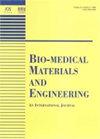射频溶脂中皮肤冷却高级 PID 控制算法的模拟指导开发
IF 1.3
4区 医学
Q4 ENGINEERING, BIOMEDICAL
引用次数: 0
摘要
背景:双极射频溶脂是一种流行的非侵入性减脂手术,其临床效果取决于有效溶脂和患者安全之间的微妙平衡,其中皮肤过热和随后的组织损伤是主要问题。目的:本研究旨在探讨一种新型双极射频溶脂技术,通过创新的 PID 温度控制算法保护皮肤。方法:利用 COMSOL Multiphysics 仿真软件,建立了一个二维脂肪和皮肤组织模型,模拟了各种 PID 温度控制方案。模拟的关键是对 45 ℃、50 ℃ 和 55 ℃ 的不同 PID 温度和恒定功率策略进行比较分析,评估它们对皮肤温度的影响。同时,还开发了一种定制的双极射频溶脂设备,并使用猪组织进行了体外实验,以进行经验验证。结果:研究结果表明,当 PID 设置为 Kp = 7、Ki = 2 和 Kd = 0,皮肤温度控制在 45 °C 或 50 °C 时,基于 PID 的创新表皮温度控制策略成功地将表皮温度控制在安全范围内。在保持温度的同时,不会影响射频溶脂的效果,大大降低了对皮肤层造成热损伤的风险。结论:我们的研究证实了这种先进的基于 PID 的双极射频溶脂技术在临床美容手术中的巨大实用价值,提高了脂肪组织消融治疗过程中的患者安全性。本文章由计算机程序翻译,如有差异,请以英文原文为准。
Simulation-guided development of advanced PID control algorithm for skin cooling in radiofrequency lipolysis
BACKGROUND:The clinical outcomes of bipolar radiofrequency (RF) lipolysis, a prevalent non-invasive fat reduction procedure, hinge on the delicate balance between effective lipolysis and patient safety, with skin overheating and subsequent tissue damage as primary concerns. OBJECTIVE:This study aimed to investigate a novel bipolar radiofrequency lipolysis technique, safeguarding the skin through an innovative PID temperature control algorithm. METHODS:Utilizing COMSOL Multiphysics simulation software, a two-dimensional fat and skin tissue model was established, simulating various PID temperature control schemes. The crux of the simulation involved a comparative analysis of different PID temperatures at 45 °C, 50 °C, and 55 °C and constant power strategies, assessing their implications on skin temperature. Concurrently, a custom bipolar radiofrequency lipolysis device was developed, with ex vivo experiments conducted using porcine tissue for empirical validation. RESULTS:The findings indicated that with PID settings of Kp = 7, Ki = 2, and Kd = 0, and skin temperature control at 45 °C or 50 °C, the innovative PID-based epidermal temperature control strategy successfully maintained the epidermal temperature within a safe range. This maintenance was achieved without compromising the effectiveness of RF lipolysis, significantly reducing the risk of thermal damage to the skin layers. CONCLUSION:Our research confirms the substantial practical utility of this advanced PID-based bipolar RF lipolysis technique in clinical aesthetic procedures, enhancing patient safety during adipose tissue ablation therapies.
求助全文
通过发布文献求助,成功后即可免费获取论文全文。
去求助
来源期刊

Bio-medical materials and engineering
工程技术-材料科学:生物材料
CiteScore
1.80
自引率
0.00%
发文量
73
审稿时长
6 months
期刊介绍:
The aim of Bio-Medical Materials and Engineering is to promote the welfare of humans and to help them keep healthy. This international journal is an interdisciplinary journal that publishes original research papers, review articles and brief notes on materials and engineering for biological and medical systems. Articles in this peer-reviewed journal cover a wide range of topics, including, but not limited to: Engineering as applied to improving diagnosis, therapy, and prevention of disease and injury, and better substitutes for damaged or disabled human organs; Studies of biomaterial interactions with the human body, bio-compatibility, interfacial and interaction problems; Biomechanical behavior under biological and/or medical conditions; Mechanical and biological properties of membrane biomaterials; Cellular and tissue engineering, physiological, biophysical, biochemical bioengineering aspects; Implant failure fields and degradation of implants. Biomimetics engineering and materials including system analysis as supporter for aged people and as rehabilitation; Bioengineering and materials technology as applied to the decontamination against environmental problems; Biosensors, bioreactors, bioprocess instrumentation and control system; Application to food engineering; Standardization problems on biomaterials and related products; Assessment of reliability and safety of biomedical materials and man-machine systems; and Product liability of biomaterials and related products.
 求助内容:
求助内容: 应助结果提醒方式:
应助结果提醒方式:


